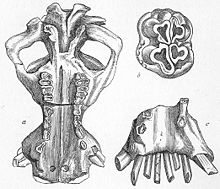Hexaprotodon
| Hexaprotodon Temporal range: Latest Miocene to Late Pleistocene
| |
|---|---|

| |

| |
| Hexaprotodon sivalensis skull elements | |
| Scientific classification | |
| Domain: | Eukaryota |
| Kingdom: | Animalia |
| Phylum: | Chordata |
| Class: | Mammalia |
| Order: | Artiodactyla |
| Family: | Hippopotamidae |
| Subfamily: | Hippopotaminae |
| Genus: | †Hexaprotodon Falconer & Cautley, 1836 |
| Type species | |
| †Hexaprotodon sivalensis | |
| Species | |
|
See text | |
| Synonyms | |
|
Hexoprotodon [sic][1] | |
Hexaprotodon is an extinct genus of hippopotamid known from Asia and possibly Africa and Europe. The name Hexaprotodon means "six front teeth" as some of the fossil forms have three pairs of incisors.[2][3]
Taxonomy[edit]
The name Hexaprotodon was often applied to the pygmy hippopotamus before its reclassification into the genus Choeropsis. The genus has been historically applied to numerous fossil hippopotamus species spanning Asia, Africa and Europe. The genus sensu lato, has been suggested to be paraphyletic with respect to both species of living hippopotamus.[2] The uncontroversial, core Asian members of the genus most closely related to the type species H. sivalensis first appeared around 6 million years ago, during the latest Miocene and were widespread throughout South and Southeast Asia, with the oldest records coming from the Siwalik Hills.[4][5] The African species Hexaprotodon bruneti from the Early Pleistocene of Ethiopia may be closely related to the Asian Hexaprotodon species, and thus belong in the genus in its more narrow sense. If so, it likely originates from a migration from Asia.[2]
Description[edit]
The Asian species of Hexaprotodon, like the living hippopotamus (Hippopotamus amphibius), but unlike the pygmy hippoptamus are thought to have had a semiaquatic ecology, with their skull shape greatly resembling that of H. amphibius, with elevated orbits that allowed them to see above water while submerged. This lifestyle likely evolved independently in both Hexaprotodon and the genus Hippopotamus. In comparison to Hippopotamus, the mandibular symphysis is much more robust, the canine processes do not extend laterally outwards, and the molar teeth are lower crowned. The more slender and less massive postcranial skeleton compared to H. amphibius also suggests that Hexaprotodon was less adapted to walking in mud.[6] Dental microwear suggests a grazing diet for Asian Hexaprotodon species, similar to H. amphibius.[7]
Extinction[edit]
Hexaprotodon was largely extinct by the Late Middle Pleistocene in Southeast Asia[4] but survived in Sumatra into the early Late Pleistocene, with one tooth dated to around 70,000 years ago.[5] The last known populations survived on the Indian Subcontinent to the very end of the Pleistocene,[4] with among the latest dates being around 16,467–15,660 cal years Before Present from bones found in the Narmada River valley in central India. Fossil evidence from a late-surviving Indian Hexaprotodon indicates that it lived during a catastrophic drought caused by the latest Heinrich event, leading to an extremely weak Indian monsoon. It is thought that these drought conditions led to a heavy habitat fragmentation due to Hexaprotodon depending on aquatic habitats, prompting an extinction vortex. Humans may have also facilitated the extinction by hunting the hippopotamuses during this vulnerable state, although no evidence of hippopotamus butchery is known from the Indian subcontinent.[4]
Species[edit]
The genus Hexaprotodon contains the following species, all from Asia and Africa:

Genus sensu lato:
- Hexaprotodon bruneti (Boisserie and White, 2004)
- Hexaprotodon coryndoni
- Hexaprotodon crusafonti (Aguirre, 1963)
- Hexaprotodon hipponensis (Gaudry, 1867)
- Hexaprotodon imagunculus (Hopwood, 1926)
- Hexaprotodon iravaticus (Falconer and Cautley, 1847)
- Hexaprotodon karumensis (Coryndon, 1977)
- Hexaprotodon mingoz (Boisserie et al., 2003)
- Hexaprotodon namadicus (Falconer and Cautley, 1847 - possibly same as H. palaeindicus)
- Hexaprotodon palaeindicus (Falconer and Cautley, 1847)
- Hexaprotodon pantanellii (Joleaud, 1920)
- Hexaprotodon primaevus (Crusafont et al., 1964)
- Hexaprotodon protamphibius (Arambourg, 1944)
- Hexaprotodon siculus (Hooijer, 1946)
- Hexaprotodon sinhaleyus (Deraniyagala)
- Hexaprotodon sivajavanicus (Hooijer, 1950)
- Hexaprotodon sivalensis (Falconer and Cautley, 1836)
- Hexaprotodon dhokwazirensis Akhtar and Bakr, 1995
Genus sensu stricto:
- Hexaprotodon bruneti (Boisserie and White, 2004)
- Hexaprotodon dhokwazirensis (Akhtar and Bakr, 1995)
- Hexaprotodon iravaticus (Falconer and Cautley, 1847)
- Hexaprotodon namadicus (Falconer and Cautley, 1847 - possibly same as H. palaeindicus)
- Hexaprotodon palaeindicus (Falconer and Cautley, 1847)
- Hexaprotodon sinhaleyus (Deraniyagala)
- Hexaprotodon sivajavanicus (Hooijer, 1950)
- Hexaprotodon sivalensis (Falconer and Cautley, 1836)

References[edit]
- ^ Seth, S. (1993), New Perspectives in Anthropology, M.D. Publications, p. 333, ISBN 9788185880198
- ^ a b c Boisserie, Jean-Renaud (2005). "The phylogeny and taxonomy of Hippopotamidae (Mammalia: Artiodactyla): a review based on morphology and cladistic analysis". Zoological Journal of the Linnean Society. 143: 1–26. doi:10.1111/j.1096-3642.2004.00138.x.
- ^ Hexaprotodon, The Paleobiology Database, läst 19 mars 2013.
- ^ a b c d Jukar, Advait M.; Patnaik, Rajeev; Chauhan, Parth R.; Li, Hong-Chun; Lin, Jih-Pai (September 2019). "The youngest occurrence of Hexaprotodon Falconer and Cautley, 1836 (Hippopotamidae, Mammalia) from South Asia with a discussion on its extinction". Quaternary International. 528: 130–137. Bibcode:2019QuInt.528..130J. doi:10.1016/j.quaint.2019.01.005. S2CID 133765385.
- ^ a b Smith, Holly E.; Price, Gilbert J.; Duval, Mathieu; Westaway, Kira; Zaim, Jahdi; Rizal, Yan; Aswan; Puspaningrum, Mika Rizki; Trihascaryo, Agus; Stewart, Mathew; Louys, Julien (2021-11-30). "Taxonomy, taphonomy and chronology of the Pleistocene faunal assemblage at Ngalau Gupin cave, Sumatra". Quaternary International. Human Evolution in the Asia-Pacific Realm: Proceedings of the 1st Asia-Pacific Conference on Human Evolution. 603: 40–63. doi:10.1016/j.quaint.2021.05.005. hdl:10072/404701. ISSN 1040-6182.
- ^ PANDOLFI, LUCA; MARTINO, ROBERTA; ROOK, LORENZO; PIRAS, PAOLO (2020-01-09). "INVESTIGATING ECOLOGICAL AND PHYLOGENETIC CONSTRAINTS IN HIPPOPOTAMIDAE SKULL SHAPE". Rivista Italiana di Paleontologia e Stratigrafia. 126 (1): V. 126 N. 1 (2020). doi:10.13130/2039-4942/12730.
- ^ Patnaik, Rajeev (June 2015). "Diet and habitat changes among Siwalik herbivorous mammals in response to Neogene and Quaternary climate changes: An appraisal in the light of new data". Quaternary International. 371: 232–243. doi:10.1016/j.quaint.2014.11.025.

